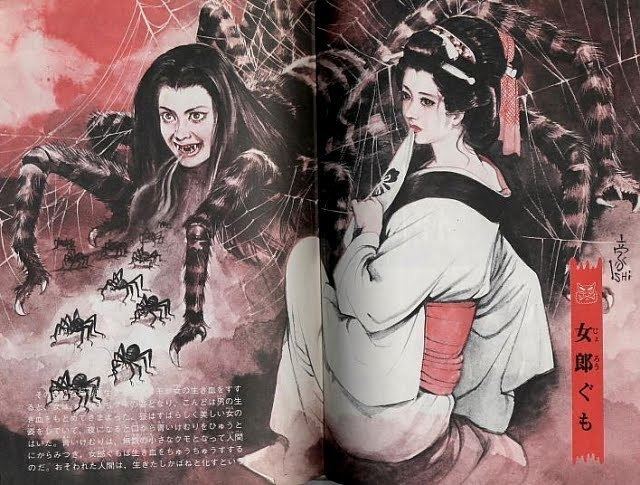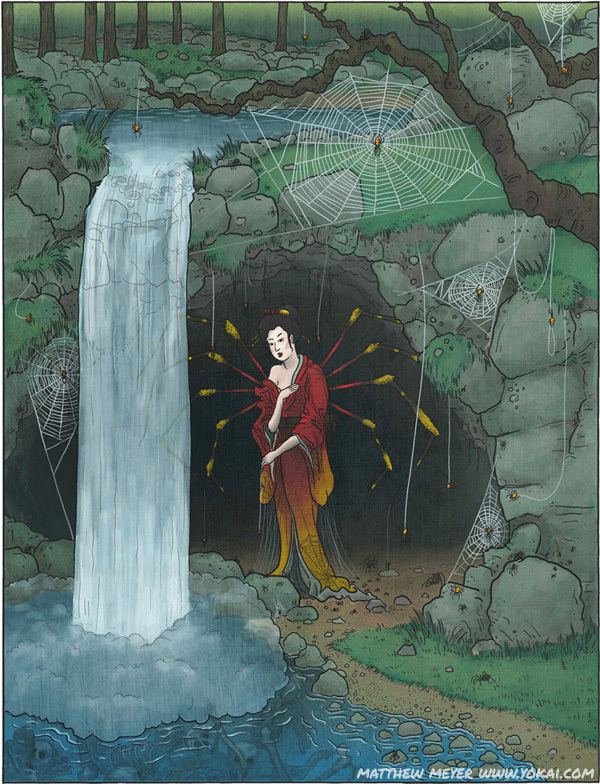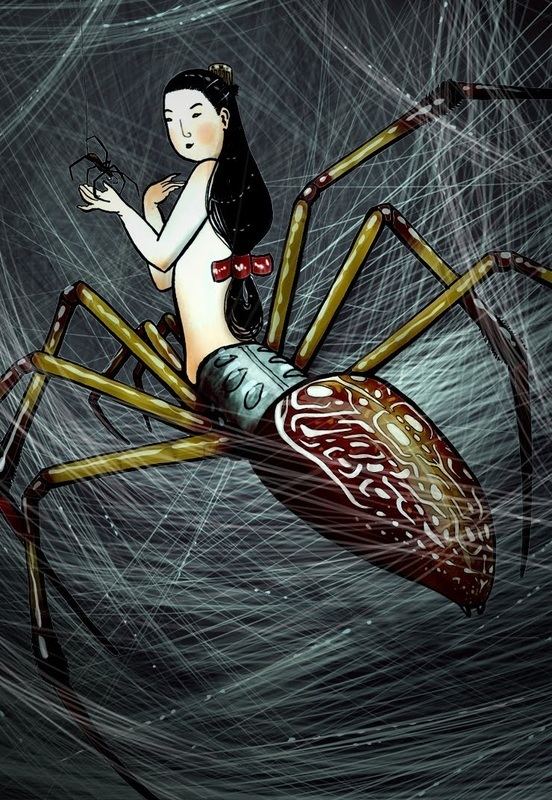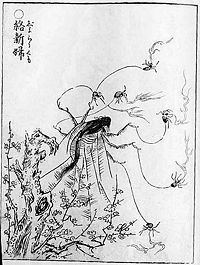 | ||
Similar Futakuchi‑onna, Yuki Onna, Kiyohime, Zashiki‑warashi, Akaname | ||
Jorōgumo (Japanese Kanji: 絡新婦, Hiragana: じょろうぐも) is a type of Yōkai, a creature, ghost or goblin of Japanese folklore. According to some stories, a Jorōgumo is a spider that can change its appearance into that of a seductive woman.
Contents
- Jor gumo spider
- Stories
- Magical spider
- Waterfall spiderwebs
- Protection from drowning
- In popular culture
- References

In Japanese Kanji, Jorōgumo is written as "絡新婦" (literally meaning "binding bride") or "女郎蜘蛛" (literally meaning "whore spider"). Jorōgumo can also refer to some species of spiders, but in casual use it can refer to the Nephila and Argiope spiders. Japanese-speaking entomologists use the katakana form of Jorōgumo (ジョロウグモ) to refer, exclusively, to the spider species Nephila clavata.

Jor gumo spider
Stories

The Edo period legend has it that a beautiful woman would entice a man into a quiet shack and begin to play a biwa, a type of Japanese lute. While the victim would be distracted by the sound of the instrument, she binds her victim in spider silk threads in order to devour the unsuspecting person as her next meal.
Magical spider

According to legend, when a spider turns 400 years old, it gains magical powers. Stories of Jorōgumo can be found in Edo period works, such as "Taihei-Hyakumonogatari" (太平百物語) and "Tonoigusa" (宿直草). In many of these stories, Jorōgumo changes its appearance into a beautiful woman to ask a samurai to marry her, or takes the form of a young woman carrying a baby (which may turn out to be a spider's eggsack).
Drawings, such as the one in Toriyama Sekien's book Gazu Hyakki Yakō, depicts Jorōgumo as a half-woman/half-spider surrounded by her spider children.
Waterfall spiderwebs

A Jorōgumo is also known as the mistress of the Jōren Falls (浄蓮の滝) in Izu, Shizuoka. The legend has it that a man was resting at the foot of the waterfall when his feet were bound with a vast number of spider threads. To free himself, he cut the threads and tied them to a stump of a tree, which was pulled from the ground and drawn into the waters.
After this incident at the Jōren waterfall, the villagers became afraid and stopped going to the waterfall. However, one day, a woodsman logger from out of town, unaware of the story of the Jōren Jorōgumo, began cutting wood in the area. After he accidentally dropped his axe into the water, he dove into the pool to find it; then a beautiful woman appeared and returned the axe, telling him never to tell anyone about her. While the logger kept the promise, he began to feel anxious about the incident. One day while he was drunk, he told his secret and finally felt at ease. He then fell into a deep sleep never to awaken again.
In a variation of the story of the Jōren waterfall, the logger falls in love with the woman Jorōgumo and starts visiting the falls every day to see her. But as time passes, he starts growing weaker and weaker. A monk from a neighboring temple believes the logger has been trapped by the spider, so he and the logger go to the waterfall together, and the monk reads a Buddhist Sūtra there. While the monk reads the sutra, spider threads appear from the pool and attempt to wrap themselves around the logger, but the monk shouts his Buddhist chant and they disappear. Though the logger soon realizes that the woman was a spider, he cannot forget his love for her. He then asks for help from a Tengu, master of the Yōkai of the mountain, but the Tengu forbids this love. The logger was unwilling to give up his love for the Jorōgumo. While running back to the waterfall he is caught by the silk threads and finally falls into the water, never to surface again.
Protection from drowning
There are many stories throughout Japan of a tree stump being pulled into the water in place of the lumberjack from the previous tale. One such example is that of Kashikobuchi (賢淵), Sendai. Here, just after the stump is pulled into the pool, the lumberjack hears a voice saying, "How clever, how clever" (賢い、賢い / Kashikoi, Kashikoi). For this event, the area came to be called Kashikobuchi, which literally means "clever abyss". In Kashikobuchi, the Jorōgumo is worshiped as a goddess who protects people from drowning, and a monument and a small Torii still stand at the location.
